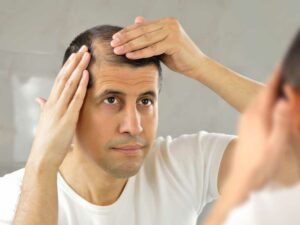There’s a long-standing trend of able people borrowing from Deaf and disabled cultures
For example, the football huddle is borrowed from Gallaudet players who huddled to prevent other teams from seeing them signing. Weighted blankets, this year’s newest trend, were first created to help people with autism cope with overwhelming sensory experiences and anxiety.
This time, Peterson uses disability as metaphor. She speaks of what “ails” us, of “affliction.” She even calls millennial burnout a “chronic disease.”
And while Peterson makes examples out of a disabled person, she doesn’t include their perspectives, history, or voices. As a result, she flattens disabled people’s very real struggles as part of millennial burnout, rather than a possible (and more likely) symptom of their condition.
Disabled people already experience erasure that contributes to our oppression. So, by using a disabled experience without consulting disabled people, Peterson’s essay contributes to that erasure.
The first example Peterson offers is of someone with ADHD who couldn’t register to vote in time.
“But his explanation — even though, as he noted, his struggle in this case was caused in part by his ADHD — triggered the contemporary tendency to dunk on millennials’ inability to complete seemingly basic tasks,” Peterson writes. “Grow up, the overall sentiment goes. Life is not that hard.”
What’s missing is the acknowledgement that being unable to complete “simple” tasks is a common experience for those with ADHD.
Disabled people are often told to “get over it.” And that’s not the same as when an abled person is told to “grow up.” Even with more visible disabilities than ADHD, such as wheelchair users, disabled people are dismissively told to “just try yoga” or turmeric or kombucha.
Brushing off disabled peoples’ very real struggles, as though we could just bootstrap our way through inaccessible environments, is a form of ableism — and so is trying to empathize with disabled people by acting as if we all experience the same feedback.
If Peterson had centered her article firmly in disabled experiences, she could’ve drawn from these experiences to further elucidate how disabled peoples’ lives are dismissed. This, perhaps, would help some readers overcome this harmful attitude.
What happens when we remove the disability experience from its roots in disability culture?
Many aspects of millennial burnout that Peterson describes resemble the common experiences of chronically ill and neurodivergent people.
But having a disability or illness isn’t limited to pain, restriction, or feeling too tired.
Again, by excluding disabled people from the narrative, Peterson misses on a very important part: Disabled people are also — and have been for a long time — working for systemic change, such as ongoing efforts to lobby for universal healthcare and the Disability Integration Act.
The independent living movement formed in the 1960s to lobby for reduced institutionalization of disabled people and to force the Americans with Disabilities Act through Congress. To demonstrate the problem with inaccessible buildings, disabled people crawled up the steps of Congress.
When Peterson asks, “Until or in lieu of a revolutionary overthrow of the capitalist system, how can we hope to lessen or prevent — instead of just temporarily staunch — burnout?” She’s missing out on the history where the disabled community has already won systemic changes that could potentially help millennials experiencing burnout.
For example, if the burnout was the result of a health condition, workers could legally ask for accommodations under the Americans with Disabilities Act.
Peterson also names her burnout symptom “errand paralysis”: “I was deep in a cycle of a tendency… that I’ve come to call ‘errand paralysis.’ I’d put something on my weekly to-do list, and it’d roll over, one week to the next, haunting me for months.”
For those with disabilities and chronic illnesses, this is known as executive dysfunction and “brain fog.”
Executive dysfunction is characterized by difficulty completing complex tasks, starting tasks, or switching between tasks. It’s common in ADHD, autism, and other mental health issues.
Brain fog describes a cognitive fog that makes it difficult to think and complete tasks. It’s a symptom of disorders such as fibromyalgia, chronic fatigue syndrome/myalgic encephalomyelitis, aging, dementia, and others.
While I’m not armchair-diagnosing Peterson with any of these issues (executive functioning is known to worsen with issues like stress and lack of sleep), she misses out by not including a disabled perspective on errand paralysis: Disabled people have developed ways of coping.
We call this accommodations or coping strategies or, sometimes, self-care.
However, rather than be informed by disabled experiences, Peterson actively dismisses modern self-care.
“Much of self-care isn’t care at all: It’s an $11 billion industry whose end goal isn’t to alleviate the burnout cycle,” Peterson writes, “but to provide further means of self-optimization. At least in its contemporary, commodified iteration, self-care isn’t a solution; it’s exhausting.”
I’ll admit, self-care can be exhausting. Yet it’s more than just the commodified version Peterson describes. The self-care Peterson writes about is the watered-down version that abled people, particularly corporations, have created out of disability culture.
Self-care for executive dysfunction is really twofold:
Make accommodations for yourself (such as reminders, simplifying tasks, asking for help) so you can hopefully complete the most necessary tasks.
Stop expecting yourself to do all of the things, or calling yourself “lazy” if you can’t.
Disabled people have ample experience feeling like we’re “lazy” for not being “productive.” Society constantly tells us we’re “burdens” on society, especially if we’re not able to work to capitalist standards.
Perhaps by listening to disabled people on such topics, abled people could better able understand or accept their own limitations. After my disability became more debilitating, it took years of practice for me to be able to pace myself and not expect the perfection our modern capitalist society demands of us.
If Peterson had reached out to the disability community, she may have been able to stem the tide of her own burnout, or at least come to a measure of self-acceptance about her limitations.
In response to the guilt of feeling “lazy,” the disabled community has pushed back, saying things such as “my existence is resistance.” We’ve realized our worth isn’t tied to productivity, and including this disability narrative would’ve given the original article it’s much-needed empowering lift.
It’s also worth noting Peterson’s article excludes the voices of people of color
She defines being a millennial as “mostly white, largely middle-class people born between 1981 and 1996.” Activists on Twitter have pushed back against this narrative.
Arrianna M. Planey tweeted in response to the piece, ‘“What is ‘adulting’ to a Black woman who has been treated like an adult since age 8?#adultification#whitherBlackgirlhood I been doing much of the work that gets called ‘adulting’ since before I was a teen.”
Additionally, Tiana Clark tweeted that Peterson explores “behaviors of a generation — my generation — but my dead black batteries are not included. The author even gives definitions for being ‘poor’ and ‘lazy,’ but doesn’t situate the hefty histories of these adjectives, especially in terms of the construct of race in the workplace.”
More of these important experiences can be seen in hashtags such as #DisabilityTooWhite and #HealthCareWhileColored.
Ultimately, there’s value in borrowing from disability culture — but it has to be an equal exchange
Abled people can’t continue to borrow from disability culture and language while treating us as “burdens.” In truth, disabled people are contributing to society in very real ways — and that needs to be acknowledged.
At best, this is an exclusion of disabled peoples’ contributions to society. At worst, this normalizes the attitude that abled people know what it is to be disabled.
So what happens when we divorce disabled experiences from disabled lives? Disability becomes just a metaphor, and disabled lives become a metaphor too, rather than an important part of the human condition. Ultimately, Peterson misses so much by writing “about us, without us.”
Liz Moore is a chronically ill and neurodivergent disability rights activist and writer. They live on their couch on stolen Pamunkey land in the D.C. metro area. You can find them on Twitter, or read more of their work at liminalnest.wordpress.com.
Written by Liz Moore on January 11, 2019
related stories
A Guide to Burnout
How to Be Human: Talking to People with Disabilities and Health Conditions





